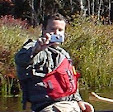 |
| Erik runs the put-in drop |
With all the rain we had this week, I knew there would be lots of rivers running this weekend. My original plan was to run the Woodstock section of the Pemigewasset River in NH, but that trip got cancelled when the river came close to flood stage at 8,000 cfs. My back-up plan was the Scantic River in CT, but that trip also got cancelled due to high water. In the end, Paul and I joined Andrew and Michael for a run on the Quinapoxet River, or the “Mighty Quin” - a nice class II/III stream located close to home about seven miles north of Worcester.
The Quinapoxet River arises in Princeton, MA, and is part of the MWRA system supplying drinking water to greater Boston. The Quinapoxet Dam in Holden impounds a billion gallons of water in the Quinapoxet Reservoir. Below the dam, the Quinapoxet River flows 8-miles east to the Wachusett Reservoir, joining the Stillwater River to become the South Branch of the Nashua River in West Boylston.
 |
| Paul runs the put-in drop |
We would be running the 3-mile section of the Quinapoxet River from River Street in Holden to the Wachusett Reservoir in West Boylston. It’s a trip that can be tough to catch, and this would only be my third run on the river. The minimum level for this trip is about 8.5-feet. I had run it before at around 10-feet. On this trip, the level would be just under 11 feet, 700 cfs. – high and fast.
After dropping my boat at the put-in, I met Paul, Andrew and Michael at the take-out to run the shuttle. When I returned to my boat, I found that I had punctured the rear float bag when I locked my boat to a tree. Float bags are used in canoes and kayaks to keep the boat from filling with water and pinning on rocks if you swim. I decided to do the trip anyway, but knew I would have to be careful not to swim.
After dropping my boat at the put-in, I met Paul, Andrew and Michael at the take-out to run the shuttle. When I returned to my boat, I found that I had punctured the rear float bag when I locked my boat to a tree. Float bags are used in canoes and kayaks to keep the boat from filling with water and pinning on rocks if you swim. I decided to do the trip anyway, but knew I would have to be careful not to swim.
 |
| Andrew does some surfing |
The river starts off with a two-foot drop at an old broken dam. There is a large standing wave and play hole at the bottom. We all ran the drop, but only Andrew ventured into the play hole to try his luck at surfing – his luck was good.
As we headed downstream, the river twists and turns though a pretty hemlock forest. Much of this area is maintained as open space as part of the Wachusett Greenway. I had hiked along the river several times with Bill and the “Papa Joe” hiking group, but it was nice to be paddling it again. We enjoyed the class II waves and rock-dodging down to the Springdale Mill.
 |
| Heading downstream |
At the Springdale Mill site, the action picks up a bit with a class III rapid at another broken dam. The easiest line though this rapid is to stay left and catch the big eddy just downstream of the dam. I went through last, and just caught the tail-end of the eddy – a close call averted.
Below Springdale are more class II rapids down to the Interstate 190 crossing, where there is an abrupt 3-foot drop. The kayaks ran this drop down the middle, blasting through the large standing wave at the bottom. I found a drier line on the right, which avoids the big wave. Above the drop is an intense rapid with rocks in the middle - I went left.
 |
| Paul and Andrew start their second run |
Links:












